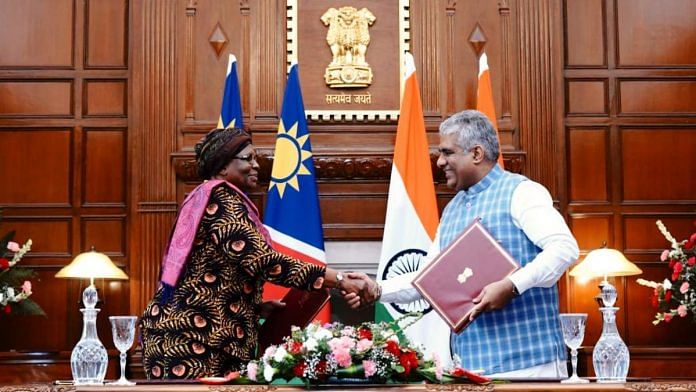New Delhi: The Modi government Wednesday signed a Memorandum of Understanding (MoU) with Namibia to bring back cheetahs to India. The Asiatic cheetah was declared extinct in India in 1952.
The MoU was signed between Union Environment Minister Bhupender Yadav and Namibia Deputy Prime Minister and Foreign Minister Netumbo Nandi Ndaitwah.
The plan to bring African cheetahs to India has been decades in the making, and Yadav called the pact “historic” in a series of tweets.
Happy to share that India has signed a historic MoU with Namibia to promote Wildlife Conservation and Sustainable Biodiversity Utilization. The MoU seeks to promote conservation and restoration of cheetah in their former range from which the species went extinct. pic.twitter.com/MNVyw8S2eQ
— Bhupender Yadav (@byadavbjp) July 20, 2022
India had approached Namibia and South Africa to source cheetahs for the introduction plan, which has triggered scepticism among some conservationists.
ThePrint reached a spokesperson for the South African environment ministry to enquire about the status of talks between the two countries, but did not receive a response until the time of publishing.
Also Read: MP’s Kuno prepares for world’s first intercontinental cheetah translocation project
‘For the ecosystem’
According to a press release issued by the Ministry of Environment, Forest and Climate Change (MoEFCC), the India-Namibia MoU “focuses on wildlife conservation and sustainable biodiversity utilisation between the two countries”.
An accompanying press note says the purpose of the cheetah introduction plan is to establish a population that will “perform its functional role as a top predator”, with a gradual growth in population expected to “contribute to its global conservation efforts”.
The press note adds that the cheetah introduction plan would help the larger ecosystem and “save not only its prey base comprising certain threatened species, but also other endangered species”, such as the caracal, Indian wolf, and birds in the bustard family.
The Kuno National Park, where the cheetahs will be kept in an enclosure, has the capacity to house 21 to 36 cheetahs.
Funding for the project will come from the MoEFCC and the National Tiger Conservation Authority, supplemented by private finance through corporate social responsibility (CSR), the government has said.
Apart from cheetah conservation, the press release says, the countries will collaborate on environmental governance, pollution and waste management, and “technological applications, mechanisms of livelihood generation for local communities living in wildlife habitats”.
The agreement was signed after much delay, reportedly because Namibia was hesitant to agree without support from India on its efforts to lift the ban on global ivory trade imposed by the Convention on International Trade in Endangered Species (CITES) — to which both countries are signatories.
The MoU, which outlines the terms of the agreement, is not yet in the public domain.
Conservationists are sceptical
Indian conservationists have expressed scepticism about the cheetah introduction plan, citing low prey base, among other reasons.
Initially, the Kuno National Park was prepared for the translocation of the Asiatic Lion, but this has been overshadowed by the cheetah relocation plan in recent years.
“If introduction of the African cheetah is a priority, why hasn’t it been included in our National Wildlife Action Plan? Lions are also top predators, and their translocation has been mandated by the Supreme Court in 2013,” said Ravi Chellam, wildlife biologist & conservation scientist. “This is a vanity project.”
“The press release mentions that the MoU’s objectives include the sustainable use of biodiversity,” he added. “It was reported that Namibia had sought India’s support to overturn the CITES ban of ivory trade. It’s important to review the details of the MoU for us to understand what really has been agreed to by India.”
(Edited by Sunanda Ranjan)
Also Read: ‘Mistakes will be made’: Why worries stalk India’s plans to bring back the cheetah






